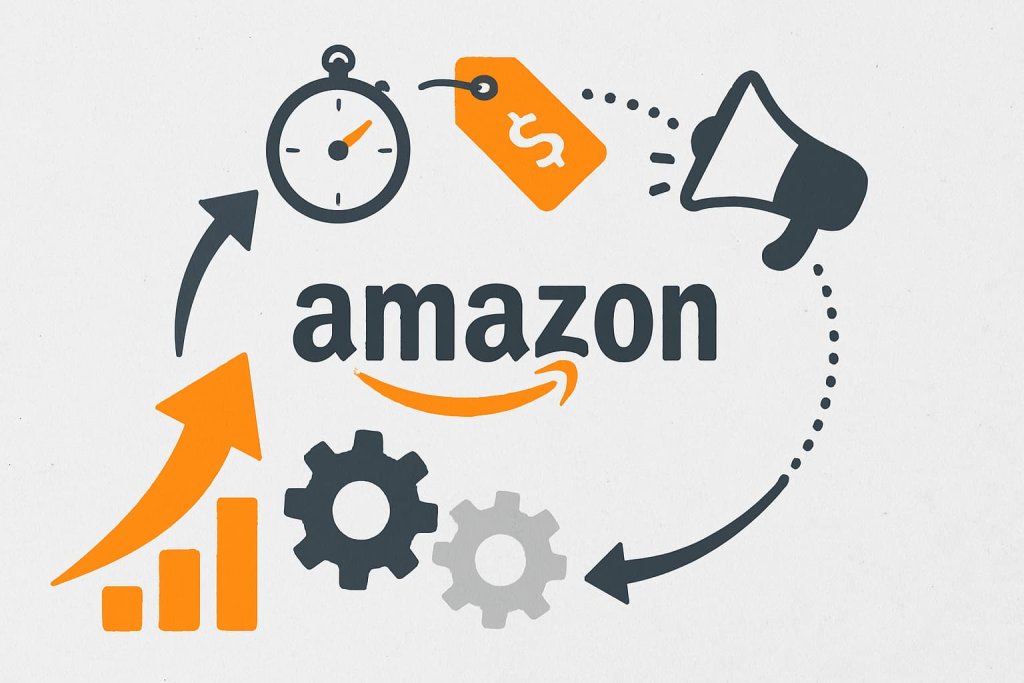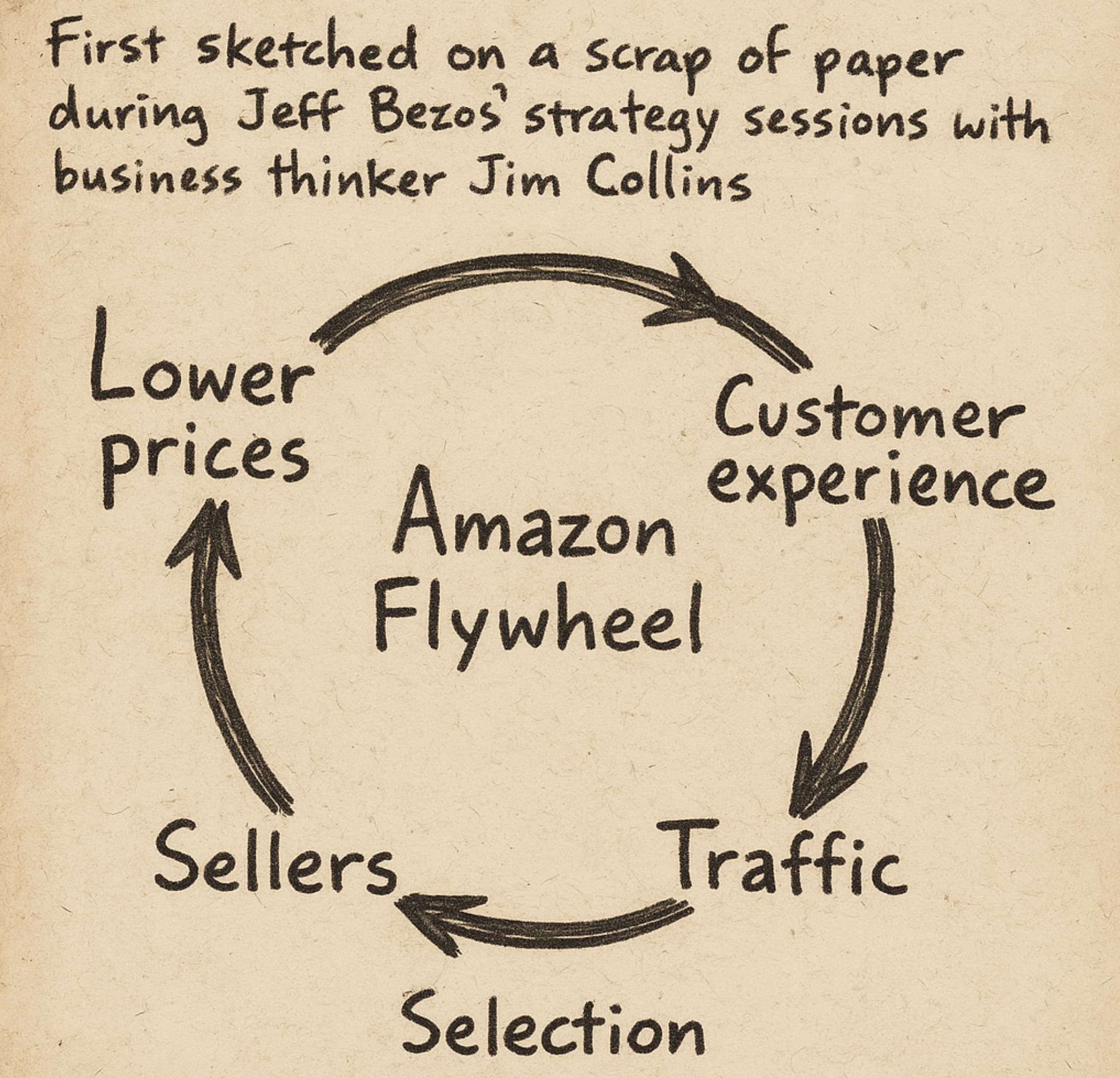The Amazon Flywheel Effect: What It Means and How to Make It Work for You
10 April 2025Imagine nudging a single listing – tightening the copy, swapping in sharper images, trimming the price by a few pence – and then watching, almost imperceptibly at first, as impressions climb, sales follow, and the entire catalogue begins to gather pace. That gentle snowballing of results is the Amazon Flywheel in action. First sketched on a scrap of paper during Jeff Bezos’ strategy sessions with business thinker Jim Collins, the model rests on a simple truth: when you improve any element of the customer experience, the marketplace algorithm rewards you with more traffic; extra traffic brings additional sales; additional sales fund further improvements, and so the wheel spins ever faster. Sellers who grasp this mechanism stop chasing one‑off hacks and start cultivating steady, compounding momentum.
The three spokes that keep the wheel turning
Amazon’s own diagram labels the spokes Selection, Price and Customer Experience, and together they form a self‑reinforcing loop. A broad, thoughtfully curated range draws shoppers in the first place. Competitive pricing then keeps those shoppers from wandering off to rivals, while a friction‑free experience – fast fulfilment, clear content, reliable after‑sales care – turns browsers into buyers and buyers into repeat customers. Each spoke feeds the others. A richer selection attracts more visitors, which justifies sharper pricing, which in turn lifts conversion and review velocity, which persuades the algorithm to send yet more visitors. Conversely, neglect any spoke and the wheel wobbles: a stock‑out throttles traffic, a pricing misstep dents Buy Box share, and a rash of negative reviews drags visibility down.
Data underlines the power of this triad. Third‑party merchants now account for well over half of all units sold on Amazon worldwide, a testament to how the platform rewards variety. Meanwhile, studies of the Buy Box show that even small price differences – fractions of a pound – can tip the balance of traffic, and customer‑centric signals such as Prime eligibility or a 4.5‑star rating often outweigh raw price alone. In short, the marketplace continuously calibrates which listings deserve to surface, and it uses these three spokes as its yardstick.
Adding momentum: practical levers for sellers

Momentum, of course, is not magic; it is the aggregate of disciplined, incremental actions. Start by mapping the gaps around your hero product and launching adjacent variants that share keywords, materials or use‑cases. A tightly knit family of SKUs amplifies advertising data and allows reviews to spill over across the range. While new lines take root, consider pricing for velocity rather than vanity. An automated repricer, constrained by sensible guardrails, can protect margin while keeping you in the hunt for critical search terms, and timed promotions – Lightning Deals, vouchers or Prime Day discounts – provide short, sharp bursts of traffic that give the wheel an extra shove.
Next, ensure Prime eligibility. Whether you choose Fulfilment by Amazon or Seller Fulfilled Prime, the blue badge removes delivery anxiety and lifts conversion almost overnight. With fulfilment handled, turn to the listing itself. Front‑load high‑intent keywords in the title, weave supporting terms into the bullet points, and replace any grainy imagery with a seven‑image carousel that shows the product in use, from multiple angles and with a lifestyle flourish. Adding A+ Content below the fold not only boosts conversion but also signals professionalism to the algorithm. Treat optimisation as an ongoing habit – set a ninety‑day cadence to revisit copy, keywords and visuals, because even modest click‑through gains compound over time.
Reviews are the grease that keeps the Flywheel spinning, yet they remain a sticking point for many sellers. The solution lies in consistency rather than gimmicks. Automate the ‘Request a Review’ email through Seller Central, respond to every piece of negative feedback within twenty‑four hours, and – where appropriate – issue a no‑quibble refund before the complaint festers. Shoppers notice the responsiveness, the rating recovers, and Amazon’s search results mirror that goodwill with greater prominence.
Finally, remember that service matters as much as sales. Fast, human replies to buyer messages, proactive stock updates and crystal‑clear return policies all feed the customer‑experience spoke. Each resolved query nudges account‑health metrics upwards, which, in Amazon’s eyes, makes you a safer bet for prominent placement.
Fuel from outside: advertising and off‑Amazon traffic
Advertising acts as the Flywheel’s starter motor. Sponsored Products defend your own keywords and harvest fresh ones, while Sponsored Brands and Sponsored Display broaden reach to shoppers higher up the funnel. The key is to watch Total Advertising Cost of Sale, not merely ACOS, so you can be sure each pound of spend drives incremental rather than cannibalistic revenue. Beyond Amazon’s walled garden, social ads, creator collaborations and well‑timed email pushes can deliver concentrated bursts of qualified traffic – especially during launches or seasonal peaks – so long as the landing pages are ready to convert. Wasted clicks slow the wheel; primed listings accelerate it.
Measuring the Flywheel’s speed
A wheel in motion must still be steered, and key performance indicators reveal whether you are pushing or merely coasting. Rising conversion rates confirm that listing tweaks and fulfilment upgrades are landing with customers. Glance views, Amazon’s proxy for impressions, expose how traffic responds to pricing changes or fresh advertising bursts. Buy Box share tells a nuanced story: if the percentage dips, a rival may be under‑pricing you, or your delivery promise may have slipped. Review velocity and average rating, viewed together, highlight product‑quality or service issues before they balloon. Lastly, Total ACOS should trend downward as organic sales take over from paid exposure. Weekly dashboards keep these signals front of mind; minor course‑corrections made quickly beat sweeping quarterly overhauls.
Pitfalls that stall momentum
Even a well‑oiled Flywheel can skid. Stock‑outs halt the loop entirely, so build safety stock into demand forecasts and set alerts well before the shelf runs bare. Pricing wars, particularly in crowded categories, can lure sellers into a race to the bottom that erodes both trust and profit. Compete on value – better bundles, richer content, superior service – rather than a penny‑pinching spiral. Negative feedback left unanswered drags account health, throttling traffic just when you need it most, and fragmented data forces decisions on lagging indicators. Centralise analytics so every tweak is informed and timely, and the wheel regains its pace.
Ready to accelerate?
The Flywheel thrives on incremental gains. Each new SKU, each five‑star review, each fulfilled promise adds another quarter‑turn, and those quarter‑turns mount quickly. Keep feeding the loop with thoughtful catalogue expansion, disciplined pricing, Prime‑level fulfilment and relentless optimisation, and growth compounds – quietly at first, then unmistakably.
If you’d like expert hands on the spokes, get in touch with Ascend’s Amazon account‑management team today. We’ll fine‑tune every lever – selection, pricing, content, advertising and operations – so your Flywheel spins faster while you concentrate on building the brand behind it.
